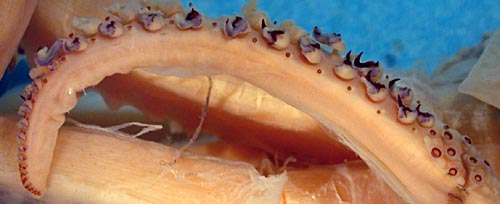Moroteuthopsis
K.S.R. Bolstad, Michael Vecchione, and Richard E. Young- Kondakovia longimana
- Kondakovia nigmatullini Laptikhovsky, Arkhipkin & Bolstad, 2008
- Moroteuthopsis aff. ingens
Introduction
Kondakovia is a sub-Antarctic to true Antarctic genus of large squids (adults to 740 mm ML), primarily set apart from similar species in Onykia by the presence of marginal sucker series on the tentacular clubs in subadults to adults.
Brief diagnosis:
An onychoteuthid ...
- with marginal suckers throughout club in subadults (unique character).
- without gladius visible beneath skin in dorsal midline.
- with 3 occipital folds.
- with fleshy longitudinal dermal ridges (K. longimana) or reticulate structure (K. nigmatullini) on the surface of the mantle.
Characteristics
- Tentacles
- Tentacular club with 23-33 hooks flanked by complete series of small marginal suckers.
- Mantle
- Mantle soft and fleshy.
- Mantle skin with longitudinal ridges in large specimens of K. longimana (Clarke, 1980) and reticulate skin in K. nigmatullini (Laptikhovsky, Arkhipkin & Bolstad, 2008). The photographs below compare the skin of K. longimana (left, middle) with the skin of Onykia robsoni (right).
- Gladius
- Gladius not visible beneath skin in dorsal midline.
- Gladius thin and fragile with 3 pairs of narrow longitudinal ribs: one borders rhachis, one at marginal rim and one inbetween the other two.
- Gladius rostrum 5-13% of ML (Laptikhovsky, Arkhipkin & Bolstad, 2008); 2-5% of ML (Clarke, 1980).
- Gladius rostrum tricornate dorsally in cross-section along conus field; convex rib present over full length of flat dorsal surface.
Distribution
This genus is thought to occupy epi- and mesopelagic waters in the Southern Ocean, where it may be circumpolar and reach northward to South Georgia and the Tasman Sea (Kubodera et al. 1998).
References
Clarke, M. R. 1980. Cephalopoda in the diet of sperm whales of the Southern Hemisphere and their bearing on sperm whale biology. Discovery Reports, 37: 1-324.
Filippova, Y.A. 1972. New Data on the Squids (Cephalopoda: Oegopsida) from the Scotia Sea. Malacologia, 11(2):391-406.
Kubodera, T., U. Piatkowski, T. Okutani and M.R. Clarke. 1998. Taxonomy and Zoogeography of the Family Onychoteuthidae (Cephalopoda: Oegopsida). Smithsonian Contributions to Zoology, No. 586: 277-291.
Laptikhovsky, V., A. Arkhipkin and K.S. Bolstad. A second species of the squid genus Kondakovia (Cephalopoda: Onychoteuthidae) from the sub-Antarctic. Polar Biology 32: 21-26.
Title Illustrations

| Scientific Name | Kondakovia longimana |
|---|---|
| Reference | Kubodera, T., U. Piatkowski, T. Okutani and M.R. Clarke. 1998. Taxonomy and Zoogeography of the Family Onychoteuthidae (Cephalopoda: Oegopsida). Smithsonian Contributions to Zoology, No. 586: 277-291. |
| Specimen Condition | Dead Specimen |
| Size | 680 mm ML |
About This Page
K.S.R. Bolstad

Auckland University of Technology

National Museum of Natural History, Washington, D. C. , USA

University of Hawaii, Honolulu, HI, USA
Correspondence regarding this page should be directed to K.S.R. Bolstad at
Page copyright © 2019 K.S.R. Bolstad, , and
 Page: Tree of Life
Moroteuthopsis .
Authored by
K.S.R. Bolstad, Michael Vecchione, and Richard E. Young.
The TEXT of this page is licensed under the
Creative Commons Attribution-NonCommercial License - Version 3.0. Note that images and other media
featured on this page are each governed by their own license, and they may or may not be available
for reuse. Click on an image or a media link to access the media data window, which provides the
relevant licensing information. For the general terms and conditions of ToL material reuse and
redistribution, please see the Tree of Life Copyright
Policies.
Page: Tree of Life
Moroteuthopsis .
Authored by
K.S.R. Bolstad, Michael Vecchione, and Richard E. Young.
The TEXT of this page is licensed under the
Creative Commons Attribution-NonCommercial License - Version 3.0. Note that images and other media
featured on this page are each governed by their own license, and they may or may not be available
for reuse. Click on an image or a media link to access the media data window, which provides the
relevant licensing information. For the general terms and conditions of ToL material reuse and
redistribution, please see the Tree of Life Copyright
Policies.
- Content changed 26 March 2019
Citing this page:
Bolstad, K.S.R., Michael Vecchione, and Richard E. Young. 2019. Moroteuthopsis . Version 26 March 2019 (under construction). http://tolweb.org/Moroteuthopsis/19953/2019.03.26 in The Tree of Life Web Project, http://tolweb.org/















 Go to quick links
Go to quick search
Go to navigation for this section of the ToL site
Go to detailed links for the ToL site
Go to quick links
Go to quick search
Go to navigation for this section of the ToL site
Go to detailed links for the ToL site